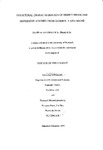STRUCTURAL CHARACTERISATION OF HIGHLY BRANCHED ISOPRENOID ALKENES FROM SEDIMENTS AND ALGAE
| dc.contributor.author | COOKE, DAVID ALAN | |
| dc.contributor.other | School of Geography, Earth and Environmental Sciences | en_US |
| dc.date.accessioned | 2013-09-13T13:00:33Z | |
| dc.date.available | 2013-09-13T13:00:33Z | |
| dc.date.issued | 1995 | |
| dc.identifier | NOT AVAILABLE | en_US |
| dc.identifier.uri | http://hdl.handle.net/10026.1/1718 | |
| dc.description.abstract |
At least fourteen C25 highly branched isoprenoid (HBI) alkenes have been previously reported in estuarine and coastal sediments from locations worldwide. The parent alkane structure has been proven but only a few of the double bond positions established previously. A wide body of evidence suggests that the compounds have a diatomaceous origin, with one report in the laboratory cultured diatom Haslea ostrearia. Alkenes with more than two double bonds appear to be rapidly removed from the hydrocarbon fraction of most sediments. There is evidence that some of the alkenes react rapidly with sulphur to form S-containing analogues. HBIs, both as hydrocarbons and S-containing analogues, may prove useful environmental indicators once the sources and exact structures have been established. A study of the temporal variations of HBI and carotenoid biomarker concentrations in Tamar sediments was conducted during 1994. The concentrations of C25 HBI alkenes exhibited strong negative correlations with those of /J-C2i:6 and fucoxanthin, common diatom markers. The strong inverse variance suggests that HBI concentrations are related to diatom populations in the Tamar estuary. Six C25 HBI alkenes ranging from a diene to hexaene have been isolated from ‘bulk' cultures of Haslea ostrearia and Caspian Sea sediments. The occurrence of HBIs in Haslea ostrearia is thus confirmed. Furthermore, the structures were unambiguously assigned by detailed nuclear magnetic resonance spectroscopy and mass spectral analysis, as well as by chemical degradation. The hydrocarbons are 2,6,10,14-tetramethyl-7-(3- methylpent-4-enyl)pentadec-5-ene; 2,10,l4-trimethyi-6-methylene-7-(3-methyIpent-4- enyl)pentadec-9-ene; 2,10,14-trimelhyl-6-methylene-7-(3-methylpent-4-enyl)pentadec- 9,13-ene; 2,10,14-trimethyl-6-methylene-7-(3-methylpent-4-enyl)pentadec-2,9,13-ene; 2,6,10,14-tetramethyl-7-(3-methyIpent-4-enyl)pentadec-2,5,9,13-ene and 2,6,10,14- tetramethyl-7-(3-methylenepent-4-enyl)pentadec-2,5,9,l3-ene. Structural elucidation of the HBI alkenes produced by Haslea ostrearia and comparison with sedimentary distributions suggests that the latter may arise from a facile double bond isomerisation of the biosynthetic compounds. The evidence presented suggests that inputs from Haslea ostrearia may account for at least eight of the dominant sedimentary HBI alkenes. The unusual behaviour exhibited by HBI alkenes during solid phase chromatography suggests that an incomplete record exists for HBI alkenes reported in the environment. | en_US |
| dc.language.iso | en | en_US |
| dc.publisher | University of Plymouth | en_US |
| dc.title | STRUCTURAL CHARACTERISATION OF HIGHLY BRANCHED ISOPRENOID ALKENES FROM SEDIMENTS AND ALGAE | en_US |
| dc.type | Thesis | |
| plymouth.version | Full version | en_US |
| dc.identifier.doi | http://dx.doi.org/10.24382/4202 | |
| dc.identifier.doi | http://dx.doi.org/10.24382/4202 |
Files in this item
This item appears in the following Collection(s)
-
01 Research Theses Main Collection
Research Theses Main


